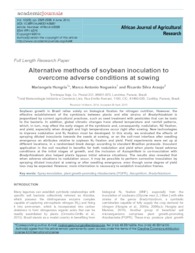Alternative methods of soybean inoculation to overcome adverse conditions at sowing.
Alternative methods of soybean inoculation to overcome adverse conditions at sowing.
Autoria: HUNGRIA, M.; NOGUEIRA, M. A.; ARAUJO, R. S.
Resumo: Soybean growth in Brazil relies solely on biological fixation for nitrogen nutrition, However, the effective establishment of the symbiosis between plants and elite strains of Bradyrhizobium is jeopardized by current agricultural practices, such as seed treatment with pesticides that can be toxic to the bacteria. In addition, global climatic changes have altered temperature and rainfall patterns, which, in turn, may affect the early stages of the symbiosis and, consequently, nodulation, N2 fixation, and yield, especially when drought and high temperatures occur right after sowing. New technologies to improve nodulation and N2 fixation must be developed. In this study, we evaluated the effects of spraying diluted inoculants towards the seeds at sowing, or on the soil-root interface after seedling emergence on attributes relative to soybean N2 fixation and yield. Field experiments were set up at different locations, in a randomized block design according to standard Brazilian protocols. Inoculant application in the soil resulted in benefits for both nodulation and yield when plants faced adverse conditions at the initial stages of growth, and the inclusion of Azospirillum in co-inoculation with Bradyrhizobium also helped plants bypass initial adverse situations. The results also revealed that when adverse situations to nodulation occur, it may be possible to perform corrective inoculation by spraying diluted inoculant at sowing or after seedling emergence, even though some degree of yield loss may be expected. However, more information is necessary to establish inoculation frames.
Ano de publicação: 2015
Tipo de publicação: Artigo de periódico
Unidade: Embrapa Soja
Palavras-chave: Fixação de nitrogênio, Inoculante, Nitrogen fixation, Soja, Soybeans
Observações
1 - Por padrão são exibidas publicações dos últimos 20 anos. Para encontrar publicações mais antigas, configure o filtro ano de publicação, colocando o ano a partir do qual você deseja encontrar publicações. O filtro está na coluna da esquerda na busca acima.
2 - Para ler algumas publicações da Embrapa (apenas as que estão em formato ePub), é necessário ter, no celular ou computador, um desses softwares gratuitos. Sistemas Android: Google Play Livros; IOS: iBooks; Windows e Linux: software Calibre.
Acesse outras publicações
Acesse a Base de Dados da Pesquisa Agropecuária (BDPA) para consultar o acervo completo das bibliotecas da Embrapa.

